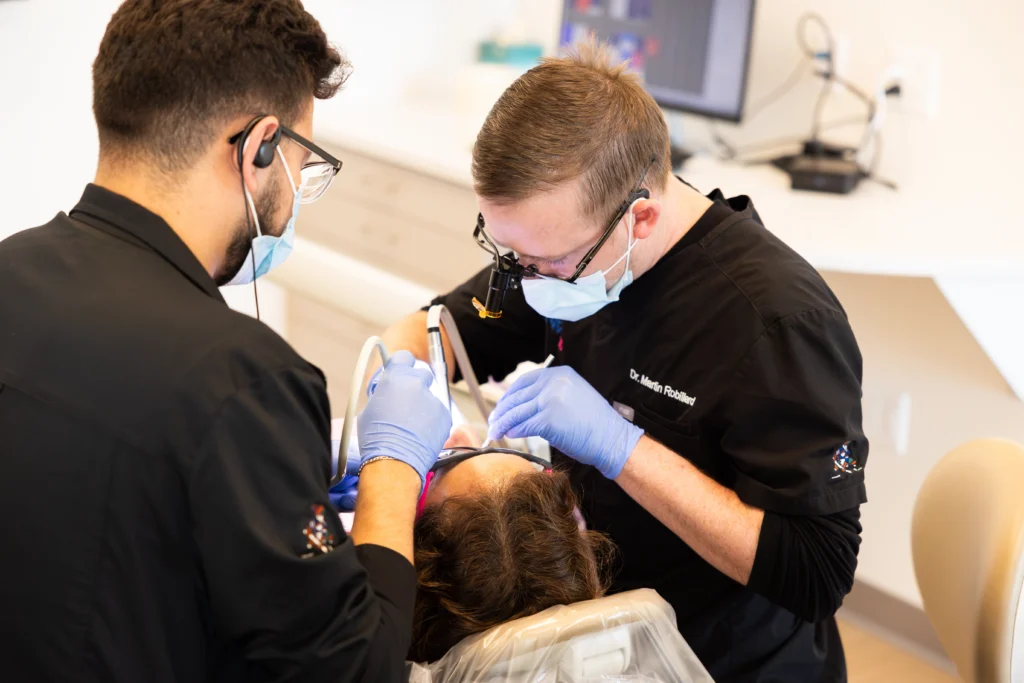As dental professionals with we often encounter patients who
are unfamiliar with the term “SRP,” or Scaling and Root Planing. This is a
common procedure performed to treat gum disease and improve overall oral health. In this blog post, let’s break down what SRP is, who may need it, and what you can expect before, during, and after the procedure.
What is Scaling and Root Planing?
Scaling and Root Planing is a deep cleaning procedure that involves removing plaque and tartar from below the gum line. It’s often recommended for patients suffering from periodontal disease, a condition that can lead to tooth loss if left untreated. The SRP procedure not only cleans the teeth but also smooths the roots to encourage healing and reattachment of the gum tissue.
Who Needs an SRP?
Patients who have been diagnosed with gingivitis or periodontitis are typically the ones who will benefit most from an SRP. Signs that you may need this procedure include:
– Swollen or bleeding gums
– Persistent bad breath
– Receding gums
– Loose teeth
If you notice any of these symptoms, it’s essential to schedule an appointment with your dental professional to assess your gum health. Our dental providers will take a perio probe to measure the gums. 1,2,3’s are a good sign. These patients do not need a deep cleaning(SRP). If you get 4,5,6’s with or without bleeding then you will see bone loss and calculus on the X-rays and that will mean you have periodontal disease. This is an irreversible disease that has chronic bacteria underneath the gums. The SRP will clean and help tighten the gums but it will not grow the bone back.
What to Expect Before the Procedure
Before the SRP procedure, you’ll have a comprehensive consultation with your dental provider. During this appointment, they will evaluate the severity of your gum disease and determine the appropriate treatment plan. You may receive local anesthesia to ensure your comfort during the procedure. It’s also a good idea to discuss any medications you are taking and inform your dentist of any allergies.
The Procedure Itself
An SRP(scaling and root planing) is usually performed in one or more visits, depending on the extent of the treatment needed. During the procedure, your dentist or hygienist will use specialized tools to remove plaque and calculus from your teeth. This is different from a traditional cleaning as the plaque and calculus is below the gumline. This is why you couldn’t clean the plaque off yourself! And this is why it costs more and takes more time than a traditional cleaning(prophy).
There are several stages in a SRP:
1) Getting the patient Numb.
2) Cleaning the top part and crown of the tooth.
3) Cleaning the root and bone under the gums.
4) Polishing the tooth.
5) Adjunctive services to aid in healing. Your provider will need to get you numb with a local anesthetic.
This is an injection! Hate injections ask for our upgraded pain free injections that we can place topically. Scalers and cavitrons are used to remove the plaque and calculus. A scaler is a hand held instrument with a sharp edge that we use to clean. A cavitron is an ultrasonic machine that helps with calculus removal by high frequency vibrations and water. The vibrations create microscopic bubbles that implode, releasing bursts of heat and pressure that help loosen and remove deposits of calculus. Once that is completed we polish the teeth to remove any stains. This is followed by adjunctive services. At DentalPros we provided adjunctive services to enhance the cleaning and aid in a faster healing time. These services include Ozone Therapy and Laser Therapy. Ozone Therapy is a process in which Medical grade Oxygen is separated and rejoined to form an unstable O3 molecule. From here it is applied to the injured tissue and rapidly kills bacteria and promotes healing. Laser therapy is used to remove bacteria and granulation tissue that has adhered to the gingival tissue once the plaque and calculus has been removed from the bone and teeth structures(root and crown). Once the procedure has been performed the idea is that now as the tissue heals it shrinks and becomes less inflamed and it attaches to the tooth and root structure. You should see a change in your pocket depths from 4,5,6’s to 3,4,5’s. You should see less bleeding when you brush your teeth. Your smelly breath will dramatically improve. You should see your energy levels rise. Once you have completed and SRP you aren’t done you have to maintain the new pocket depth and return regularly to prevent the pockets from coming back. The cleaning you get at this point at 3, 4, and 6 month intervals is called a perio-maintenance and the intervals are determined by you and your provider.
After the Procedure: What to Expect
Post-treatment care is crucial for the success of the SRP. Here’s what to expect in the days following your procedure:
1. Sensitivity: It’s common to experience some tooth sensitivity after an SRP. This may last for a few days, but over-the-counter pain relief can help manage discomfort.
2. Bleeding: Some patients may notice light bleeding, especially when brushing. This should subside within a few days.
3. Oral Hygiene: Your dentist will likely recommend adjusting your oral hygiene routine. Gentle brushing and rinsing with a prescribed mouthwash might be
advised to promote healing.
4. Follow-Up Appointment: You will need to return for a follow-up visit to monitor your healing progress. Your dentist will assess the treatment’s effectiveness and may recommend additional procedures if necessary.
5. Long-Term Care: To maintain optimal gum health, regular cleanings and good oral hygiene practices at home are essential. Your dentist will provide personalized advice on how often you should return for check-ups.
Ready to Start Your Journey?
Scaling and Root Planing is an effective treatment for gum disease that can significantly improve your oral health when performed correctly. Being informed about the procedure and what to expect can help alleviate any concerns you may have. If you suspect you need an SRP or want to learn more about maintaining healthy gums, don’t hesitate to reach out to your dental care provider.


